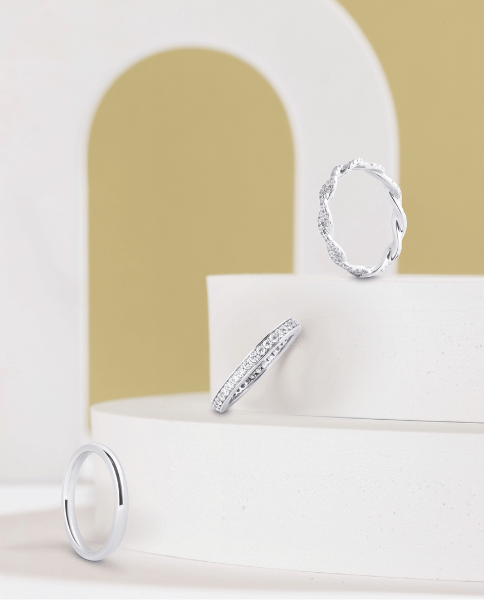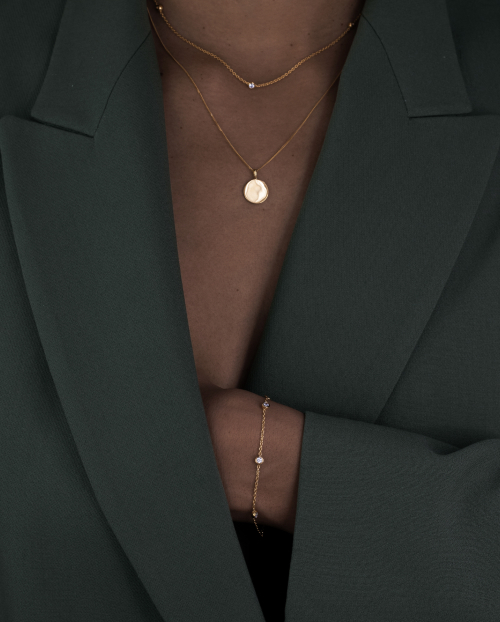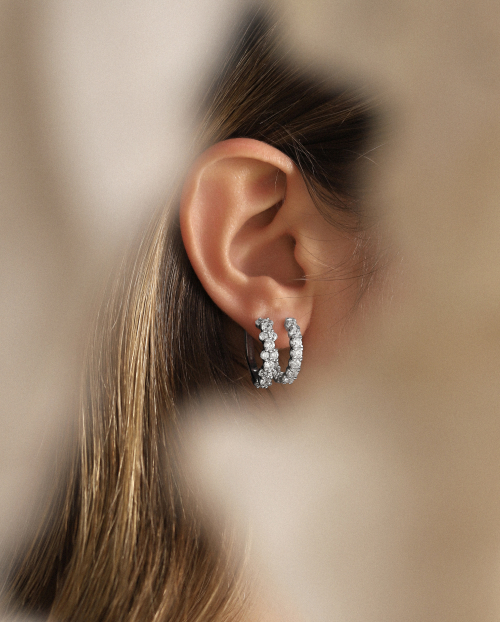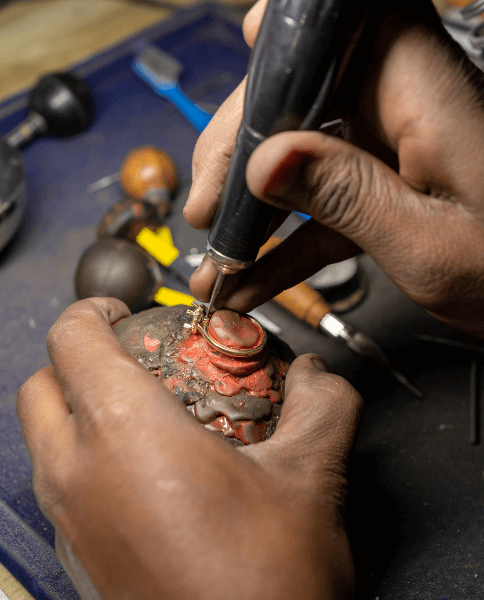Answered: What are blood diamonds?
You have probably heard of blood diamonds at some point. They have been a hot topic in the news and they are featured in a lot of pop-culture such as TV shows and movies. Although they initially appear to be of fictional creation, blood diamonds, and their impact, are actually very real.
Despite what it may sound like, the name blood diamond has nothing to do with the colour of the gemstone itself –there are many clear, pink, and even yellow diamonds that are blood diamonds.
So what is a blood diamond, and how can you avoid them? Read on to learn more about what blood diamonds are, why people are choosing alternatives, and how you can make sure the diamond you’re buying is conflict-free.
Are conflict diamonds blood diamonds?
Yes. Blood diamonds are also known by many other names, such as conflict diamonds or red diamonds (even though they’re not always red). These gemstones are diamonds that have been mined in a war zone and sold off to help finance an insurgency, an invading army’s war efforts, terrorism, or a warlord’s activity. They are known as blood diamonds to highlight the negative consequences of the diamond trade in particular areas or to label an individual diamond that has come from an area such as this.
Blood diamonds were left mostly unchecked – and thought to make up around 25% of diamond trades – until stronger regulations and certifications came into effect to try and prevent the buying and selling of blood diamonds. Despite this, an estimated 5-10% of diamonds on the international market are considered conflict diamonds.
The World Diamond Council: the diamond mining authority
The World Diamond Council is the global regulatory authority for diamond mining. The council is made up of experts, scientists, designers, and leaders from various diamond industry giants, and was founded to help manage the legitimate diamond trade.
The council was set up in July 2000 in Antwerp, Belgium, after a joint meeting of the World Federation of Diamond Bourses (WFDB) – representing all the world’s diamond trading centers – and the International Diamond Manufacturers Association (IDMA). They speak for and manage the diamond industry together.
The history of blood diamonds
The term ''blood diamond'' was first used during the late 1990s in war zones within Africa. As a result of the many diamond pockets found in different regions of the continent, like Sierra Leone, the stones are produced in areas controlled by rebel forces that are opposed to internationally recognized governments. The rebels sell these diamonds, and the money is used to purchase arms or to fund their military actions and conflicts.
In response to these conflicts in relation to the diamond trade, the United Nations (UN) enacted legislation to hinder the sale of blood diamonds – defined as any diamond mined in areas controlled by forces opposed to the legitimate, internationally recognized government of a country and sold to fund military action against that government.
In 2003, the Kimberley Process Certification Scheme (KPCS) was established to prevent blood diamonds from entering the world market. Though deemed integral in keeping blood diamonds out of global trade in the proceeding years, the KPCS has come under scrutiny for not doing enough.
Impact of blood diamonds on communities
The mining and production of blood diamonds has severe social and environmental impacts on the local communities.
Violence
Even though many civil wars on the African continent have now ended, violence in the diamond mines themselves remains a serious problem. Diamonds are still mined by hand and the workers face terrible working conditions and human rights abuse, including forced labor, beatings, torture, and murder.
Labor
Many of the world's diamonds are mined using exploitative practices, taking advantage of their workers, children, and local communities. Around 1 million miners in Africa earn less than a dollar a day, causing widespread poverty and suffering. Artisanal miners work in extremely unsafe conditions, usually without safety equipment, or proper tools so risk of injury is high.
Environment
Due to poor regulation and bad planning, diamond mining also has severe environmental impact. The practice is known to damage the land and water around the area (because sites are almost always close to rivers) Not only that, but irresponsible mining is also responsible for causing soil erosion, deforestation, and has forced local communities to relocate.
How to avoid buying blood diamonds
One of the best ways to avoid buying blood diamonds is to ask for a Diamond Certification when you purchase an item of diamond jewellery. If the diamond is certified conflict-free, your jeweller should have no problem with providing a certification of authenticity for you. These certificates provide a summary of the specifications and authenticity of the diamond you have just purchased, including the origin.
You could also look into alternatives to diamonds, such as moissanite or buy your gemstones from somewhere that sources second-hand diamonds. Another option is to choose lab grown diamonds, which we’ll expand on later.
The Kimberley Process
In 2003, the Clean Diamond Trade Act (CDTA) came into effect. This act implemented the Kimberley Process Certification Scheme (KPCS) to regulate the commercial sale of diamonds. The KPCS is an international system of nations that refuse to participate in the blood diamond trade and also an organisation that inspects diamonds themselves to ensure they are not connected to any known conflicts.
The Kimberley Process requires certification that traces where diamonds are mined diamonds and, therefore, can trace a blood diamond back to its roots. This means that interested parties can quickly find information about the diamond miners responsible and was designed to help guarantee the end of conflict mining and blood diamonds.
Smuggling
However, just as with any illegal substance or controlled trade, blood diamonds are still the victims of smuggling.
The Kimberley Process should have eliminated conflict diamonds from the mined market – and it has certainly minimised it, with only 5-10% of the world’s diamonds being illegally traded vs the 25% it was before 2003. However, a certification from the Kimberley Process doesn’t apply to just one stone but rather a collection of rough diamonds that have been cut and shipped worldwide. Because of this, smugglers will hide conflict diamonds inside shipments of other certified conflict-free stones.
So while the Kimberley Process has certainly helped to slow down part of the blood diamond trade, it’s not watertight. Therefore, it’s not possible to know with 100% confidence whether a Kimberley Process certified diamonds is completely conflict free. So, if you want to avoid blood diamonds with absolute surety, what do you do?
We recommend opting for lab grown diamonds instead.
Purchase Lab Grown Diamonds
Lab grown diamonds are diamonds that have been created in a lab setting rather than mined out of the ground, where they formed naturally. Because of this, they are guaranteed to be 100% conflict-free and are also more eco-friendly. Additionally, the are often just as stunning as some of the highest quality natural diamonds but are a fraction of the price, allowing you to get more diamond for your budget.
All of SACET’s diamond jewellery uses ethically sourced and conscious materials – including lab grown diamonds – so you can rest assured that your money is not going to fund war campaigns or unrest in other parts of the world. Shop our stunning range of ethical engagement rings for your loved one.
FAQs
Why do they call it blood diamond?
Blood diamonds are call such to highlight the negative consequences of the diamond trade in war-torn areas or to label an individual diamond that has come from an area such as this.
Are blood diamonds illegal?
Yes. It is illegal to buy and sell conflict diamonds.
Why is blood diamond a problem?
Blood diamonds are a problem because they help to fund rebel causes and civil wars, are mined by workers in unsafe conditions that violate human rights and contribute to environmental degradation.

















































